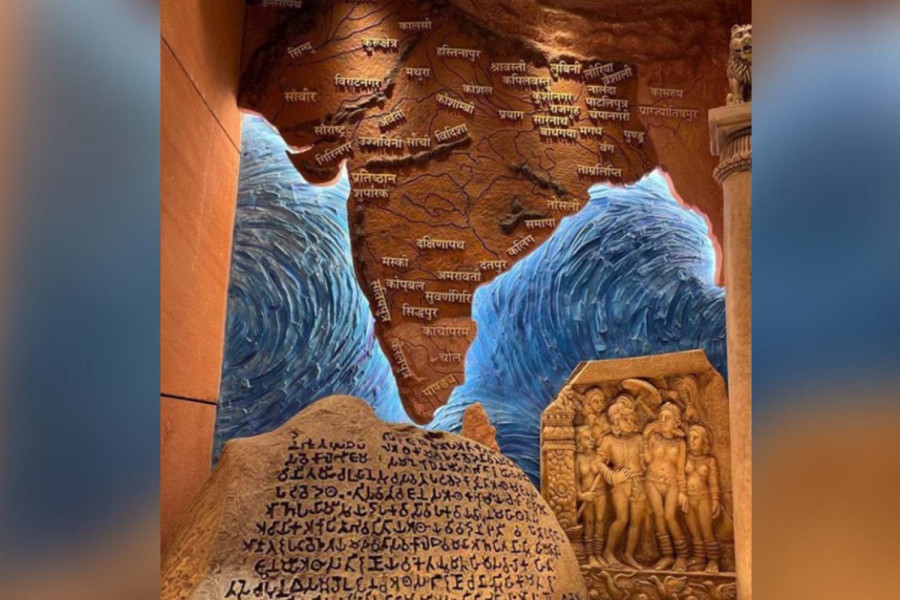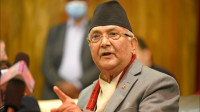National
Nepal tells its envoy to take up mural issue with India
Lawmakers in parliamentary panel raise concerns over Tarai inundation caused by roads across the border.
Anil Giri
The Ministry of Foreign Affairs on Monday instructed the Nepali Embassy in New Delhi to seek answers from the Indian foreign ministry about a controversial mural in India’s new parliament building. The mural titled ‘Akhand Bharat’—or ‘Undivided India’—has stoked controversy as it shows parts of several South Asian countries, including Nepal’s Lumbini and Kapilvastu, as India.
“On Monday, the government instructed us to seek an official answer from India's Ministry of External Affairs regarding the mural in the Indian parliament,” a New Delhi-based Nepali diplomat told the Post.
Indian Prime Minister Narendra Modi inaugurated the new parliament building on May 28.
After the mural sparked controversy in Nepal, Bangladesh and Pakistan, India’s Minister for External Affairs S Jaishankar clarified on June 8 that the wall painting of ‘undivided India’ shows the spread of the Maurya empire of emperor Ashoka (304-232 BC), and encapsulates the idea of responsible and people-oriented governance.
The mural shows ancient India from Taxila or Takshashila, which is currently in Pakistan, to a few other ancient cities that are currently inside Nepal and Bangladesh.
CPN-UML chair and former prime minister KP Oli, former prime minister Baburam Bhattarai, and some other lawmakers had also questioned the Indian mural and urged the government to take up the matter with New Delhi.
Protesting against the Indian mural, a few days ago, Kathmandu Mayor Balen Shah installed the map of pre-Sugauli treaty “Greater Nepal” in his office.
Earlier, Prime Minister Pushpa Kamal Dahal during his visit to India earlier this month had instructed the Nepali Embassy in New Delhi to gather information on the disputed mural.
The Nepali Embassy in New Delhi has already sent its report to Kathmandu stating that the mural depicts the ‘cultural’ aspects of the Ashoka Empire and it has historical and cultural significance and does not have much to do with present-day reality, a foreign ministry official told the Post.
After receiving the report from the Nepali Embassy in New Delhi, the Ministry of Foreign Affairs on Monday sent another instruction to the embassy to take up the matter with India’s Ministry of External Affairs, the official privy to the development, said.
But Foreign Minister NP Saud, speaking at the Parliament’s International Relations Committee on Tuesday, said that the government has instructed the Nepali Embassy in New Delhi to send a report on the mural. But he did not mention the embassy’s response or Monday’s second instruction issued to the embassy.
“That is not a political map as per the Indian foreign minister, who has also made an official statement about which the committee is aware. We have already instructed the Nepali Embassy in New Delhi to send a report. The government has taken the mural in the Indian parliament seriously,” the minister told the committee.
“There is a national consensus on the issue of Nepal’s international boundary and we are aware that an amendment was made to the constitution of Nepal on June 13, 2020 to update our national map,” said Saud.
Saud also said the prime minister, during his India visit, was not fully briefed on the mural issue and hence refrained from commenting on it.
Some lawmakers at the committee questioned whether proper protocol was followed when Prime Minister Pushpa Kamal Dahal visited India from May 31 to June 3.
CPN-UML lawmaker Surya Thapa asked Saud why the prime minister’s daughter Ganga Dahal was present at Dahal’s meeting with India’s National Security Adviser and Indian Foreign Secretary Vinay Mohan Kwatra.
While Bhim Acharya, Sunita Baral, Damador Poudel Bairagi and Thapa, among others, claimed that protocol was disregarded during the prime minister’s India visit, some ruling party lawmakers said there is an international practice allowing prime ministers and presidents to to take along their children on high-level visits.
Bimalendra Nidhi of the Nepali Congress and Barsha Man Pun of the CPN (Maoist Center) defended the government saying former presidents Ram Baran Yadav and Bidhya Devi Bhandari and prime minister Girija Prasad Koirala had taken along their daughters on foreign visits.
“In the absence of the spouse, heads of state and heads of government used to take along their daughters on such high-level visits,” said Pun, adding, “we can discuss whether we should continue such practice so as to avoid controversy. The foreign ministry should decide the matter.”
Minister Saud said the children of prime ministers and presidents accompanying their parents during high-profile visits was normal practice.
“Former prime minister Koirala took along his daughter Sujata and the daughters of former presidents [Ram Baran] Yadav and [Bidya Devi] Bhandari had accompanied their parents on several foreign trips,” Saud said.
At the meeting, Pun said that Nepal should conduct its foreign policy by factoring its geopolitical sensitivity.
“While conducting diplomacy, we should rise above partisan politics and keep our national interests at the core. Otherwise the country will face more problems,” said Pun.
Nepali Congress lawmaker Nidhi and CPN (Unified Centre) chief Madhav Nepal complained that Nepal failed to take up the issue of Tarai inundation during Prime Minister Dahal visit to India.
“Both Nepal and India should be mindful of bilateral treaties, agreements and international laws, but India has been unilaterally building dams along the Nepal-India border under the pretext of building roads and these have threatened Nepali territories,” Nidhi said.
“India should seek Nepal’s permission before building roads, which are in fact dams, on the Indian side of the border. Why is the Nepal government not taking these constructions seriously?”




 5.4°C Kathmandu
5.4°C Kathmandu









%20(1).jpg&w=300&height=200)



